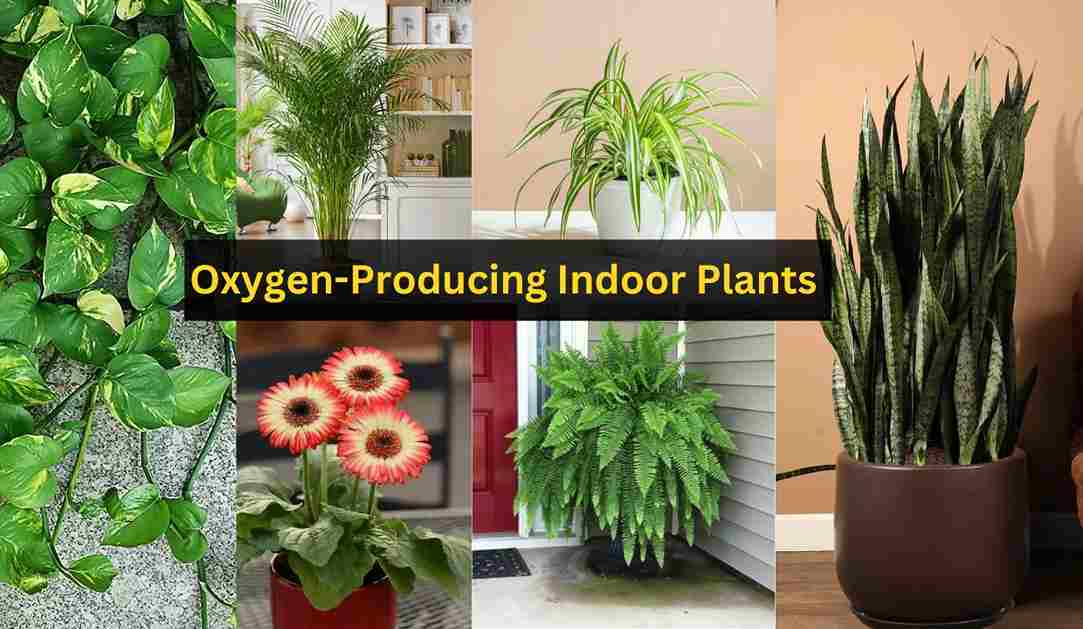Indoor Plants: In the fast-paced 21st century, where our lives revolve around technology and urban landscapes, creating a sanctuary within our homes and workspaces has become imperative. The importance of a healthy living environment amidst this modern hustle cannot be overstated. Introducing nature into our indoor spaces has taken on a new level of importance.
One powerful way to achieve this is by bringing in oxygen-producing plants. These green companions not only enhance aesthetics but also serve as natural air purifiers, offering a breath of fresh air amidst the concrete jungles we inhabit.
Let’s delve into the realm of these 7 essential indoor plants that harmonize nature with our contemporary lifestyles.
What is oxygen-producing plants?
Oxygen-producing plants, also known as oxygenators or oxygenic plants, are those that perform photosynthesis, a process where they utilize sunlight, water, and carbon dioxide to produce oxygen as a byproduct. These plants release oxygen into the atmosphere as a result of this natural process.
Why Should We Install Oxygen-Producing Plants?
The benefits of having these plants are vast:
- Air Purification: Oxygenating plants absorb toxins like formaldehyde and benzene, promoting cleaner indoor air.
- Health Enhancement: Increased oxygen levels aid in better breathing, reducing stress, and improving overall well-being.
- Environmental Balance: These plants help maintain the delicate balance of gasses in our ecosystem.
- Aesthetic Appeal: Beyond their functional benefits, these plants add beauty and tranquility to any space.
- Increased Productivity: Studies suggest that being around greenery can boost productivity and concentration.
Here are the 7 highest-oxygen-generating plants:
1. Areca Palm
Scientific name: Dypsis lutescens
Did you know that, according to a NASA study, the Areca palm is ranked among the top air-purifying plants? It can remove up to 1,000 micrograms of formaldehyde per hour from the air, making it an efficient natural air filter.
The Areca Palm, known for its lush fronds and tropical vibes, tops the charts as an exceptional air-purifying plant. Placing one of these palms in your space not only elevates aesthetics but also significantly improves air quality by releasing copious amounts of oxygen.
How to take care
- Provide indirect sunlight and well-draining soil.
- Regular watering and occasional misting to maintain humidity levels.
2. Spider Plant
Scientific name: Chlorophytum comosum
Research suggests that spider plants have the ability to remove around 95% of toxins, such as carbon monoxide and xylene, from indoor air within 24 hours of placement.
Don’t be fooled by its delicate appearance; the spider plant is a powerhouse when it comes to oxygen production. Its slender leaves elegantly arch outward, adding a touch of grace to any setting.
How to take care
- Prefers slightly dry soil between waterings.
- Trimming its offshoots, or “spiderettes,” encourages growth.
3. Snake Plant
Scientific name: Sansevieria trifasciata
Also known as Mother-in-Law’s Tongue, the Snake Plant is a low-maintenance champion in the realm of indoor greenery. With its upright, sword-shaped leaves, this plant is a top choice for oxygen production and air purification.
How to take care
- Tolerates low light and irregular watering.
- Ensure its soil drains well and avoid overwatering to prevent root rot.
4. Money Plant (Golden Pothos)
The Money Plant, or Golden Pothos, isn’t just a symbol of prosperity; it’s a stellar air-purifying plant too. Its heart-shaped leaves and trailing vines make it a popular choice for hanging baskets or as a climbing vine.
How to take care
- Thrives in moderate light but can adapt to various conditions.
- Keep its soil consistently moist but not waterlogged to maintain its vibrant foliage.
5. Peace Lily
According to research by the American Society for Horticultural Science, peace lilies were found to reduce airborne volatile organic compounds (VOCs) by up to 60% within 24 hours, indicating their remarkable air-purifying capabilities.
The elegant white blooms of the Peace Lily exude tranquility while also improving indoor air quality.
How to take care
- Allow the soil to slightly dry out between waterings.
- Pruning spent flowers and wiping its leaves gently to remove dust help the Peace Lily grow.
- Flourishes in low to medium light conditions and prefers evenly moist soil.
6. Gerbera Daisy
Known for its vibrant and colorful blooms, the Gerbera Daisy is not just a feast for the eyes but also a contributor to fresh oxygen production indoors.
How to take care
- Grows in bright, indirect light.
- Requires well-draining soil to prevent root rot.
- Do regular watering.
7. Boston Fern
Scientific name: Nephrolepis exaltata
The lush and feathery foliage of the Boston Fern adds a touch of elegance to any indoor space. It ranks high in oxygen production and thrives in high humidity and indirect light.
How to take care
- Regular watering to keep the soil consistently moist.
- Occasional misting to mimic its natural habitat will keep this fern flourishing.
General tips to keep your plants healthier:
- Light: Understand each plant’s light requirements and place them accordingly. Most thrive in indirect sunlight.
- Watering: Avoid overwatering, as it can lead to root rot. Ensure proper drainage in pots and allow the soil to dry out slightly between waterings. Use a pot saucer.
- Humidity: Some plants, like the Boston Fern and Peace Lily, appreciate higher humidity. Misting or using a humidifier can help replicate their natural environment.
- Pruning: Regularly remove dead leaves or spent blooms to encourage new growth and maintain plant health.
- Potting Mix: Use well-draining soil specific to each plant’s needs to prevent waterlogging.
Wrapping Up
Introducing these oxygen-producing indoor plants into your home or office not only enhances the aesthetic appeal but also contributes to a healthier environment. Experiment with different varieties and find the ones that thrive best in your specific indoor conditions. Let nature work its magic as these green companions elevate the oxygen levels and transform your space into a refreshing oasis.




